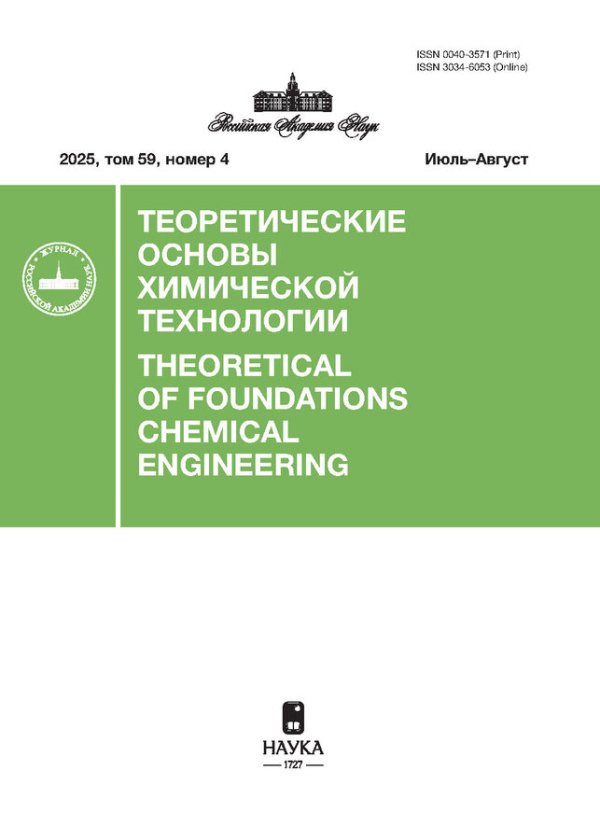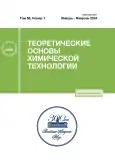Новые гидрофобные нефтесорбенты на основе кремнийоксидных аэрогелей
- Авторы: Полевой Л.А.1, Санджиева Д.А.2,3, Баранчиков А.Е.1, Гайзуллин А.Д.2, Убушаева Б.В.2,3, Иванов В.К.1, Бузник В.М.1,2, Дедов А.Г.2,3
-
Учреждения:
- Институт общей и неорганической химии им. Н.С. Курнакова РАН
- Российский государственный университет нефти и газа
- Институт нефтехимического синтеза РАН
- Выпуск: Том 58, № 1 (2024)
- Страницы: 103-114
- Раздел: Статьи
- Статья опубликована: 21.07.2024
- URL: https://journals.rcsi.science/0040-3571/article/view/260038
- DOI: https://doi.org/10.31857/S0040357124010137
- EDN: https://elibrary.ru/YWKWAR
- ID: 260038
Цитировать
Полный текст
Аннотация
В ходе двухстадийного золь-гель процесса были синтезированы усовершенствованные гидрофобные кремнийоксидые аэрогели для сорбции нефти. Структура и состав полученных аэрогелей были изучены методами ИК-спектроскопии, низкотемпературной адсорбции азота, растровой электронной микроскопии, термического анализа. Функциональные свойства были оценены путем исследования кинетики сорбции сырой тяжелой нефти, а также путем измерения нефтеемкости, влагоемкости и контактного угла смачивания. Показано, что использование различных соотношений алкоксидов в ходе синтеза дает возможность варьировать текстурные и сорбционные характеристики кремнийоксидных аэрогелей, обладающих низкой влагоемкостью (0–1 г/г) и высокой скоростью сорбции (максимальная сорбционная нефтеемкость 11,5 г/г достигается за 10 мин).
Об авторах
Л. А. Полевой
Институт общей и неорганической химии им. Н.С. Курнакова РАН
Email: delya_sand@mail.ru
Россия, Москва
Д. А. Санджиева
Российский государственный университет нефти и газа; Институт нефтехимического синтеза РАН
Автор, ответственный за переписку.
Email: delya_sand@mail.ru
Россия, Москва; Москва
А. Е. Баранчиков
Институт общей и неорганической химии им. Н.С. Курнакова РАН
Email: delya_sand@mail.ru
Россия, Москва
А. Д. Гайзуллин
Российский государственный университет нефти и газа
Email: delya_sand@mail.ru
Россия, Москва
Б. В. Убушаева
Российский государственный университет нефти и газа; Институт нефтехимического синтеза РАН
Email: delya_sand@mail.ru
Россия, Москва; Москва
В. К. Иванов
Институт общей и неорганической химии им. Н.С. Курнакова РАН
Email: delya_sand@mail.ru
Россия, Москва
В. М. Бузник
Институт общей и неорганической химии им. Н.С. Курнакова РАН; Российский государственный университет нефти и газа
Email: delya_sand@mail.ru
Россия, Москва; Москва
А. Г. Дедов
Российский государственный университет нефти и газа; Институт нефтехимического синтеза РАН
Email: delya_sand@mail.ru
Россия, Москва; Москва
Список литературы
- Pirzada T., Ashrafi Z., Xie W. et al. Cellulose silica hybrid nanofiber aerogels: from sol–gel electrospun nanofibers to multifunctional aerogels. // Adv. Funct. Mater. 2020. V. 30. № 5.
- Babiarczuk B., Lewandowski D., Kierzek K. et al. Mechanical Properties of Silica Aerogels Controlled by Synthesis Parameters // J. Non. Cryst. Solids 2023. V. 606. P. 122171.
- Venkateswara Rao A., Kalesh R.R., Amalnerkar D.P. et al. Synthesis and characterization of hydrophobic TMES/TEOS based silica aerogels // J. Porous Mater. 2003. V. 10. № 1. P. 23.
- Błaszczyński T., Ślosarczyk A., Morawski M. ynthesis of Silica Aerogel by supercritical drying method // Procedia Eng. 2013. V. 57. P. 200.
- Hüsing N., Schwertfeger F., Tappert W. et al. Influence of supercritical drying fluid on structure and properties of organically modified silica aerogels // J. Non. Cryst. Solids 1995. V. 186. P. 37.
- Maleki H., Durães L., Portugal A. An Overview on silica aerogels synthesis and different mechanical reinforcing strategies // J. Non. Cryst. Solids 2014. V. 385. P. 55.
- Yu H., Liang X., Wang J. et al. Preparation and characterization of hydrophobic silica aerogel sphere products by co-precursor method // Solid State Sci. 2015. V. 48. P. 155.
- Hüsing N., Schubert U. Aerogels-airy materials: chemistry, structure, and properties. // Angew. Chem. Int. Ed. Engl. 1998. V. 37. № 1–2. P. 22.
- Negreiros A.C.S.V. de, Lins I.D., Maior C.B.S. et al. Oil spills characteristics, detection, and recovery methods: a systematic risk-based view // J. Loss Prev. Process Ind. 2022. V. 80. P. 104912.
- Pierre A.C., Pajonk G.M. Chemistry of aerogels and their applications // Chem. Rev. 2002. V. 102. № 11. P. 4243.
- Ahmad S., Ahmad S., Sheikh J.N. Silica centered aerogels as advanced functional material and their applications: a review // J. Non. Cryst. Solids 2023. V. 611. P.
- Issa A.A., El-Azazy M., Luyt A.S. Kinetics of alkoxysilanes hydrolysis: an empirical approach // Sci. Rep. 2019. V. 9. № 1. P. 17624.
- Issa A.A., Luyt A.S. Kinetics of alkoxysilanes and organoalkoxysilanes polymerization: a review // Polymers (Basel). 2019. V. 11. № 3.
- Sinkó K. Influence of chemical conditions on the nanoporous structure of silicate aerogels // Materials (Basel). 2010. V. 3. № 1. P. 704.
- Harreld J.H., Ebina T., Tsubo N. et al. Manipulation of pore size distributions in silica and ormosil gels dried under ambient pressure conditions // J. Non. Cryst. Solids 2002. V. 298. № 2–3. P. 241.
- Sert Çok S., Koç F., Dudás Z. et al. The methyl functionality of monolithic silica xerogels synthesized via the co-gelation approach combined with surface silylation // Gels 2022. V. 9. № 1. P. 33.
- Nowak B., Bonora M., Gac J.M. Modification of polypropylene fibrous filters with MTMS-based aerogel for improvement of oil mist separation properties – experimental and theoretical study // J. Environ. Chem. Eng. 2022. V. 10. № 3. P. 107852.
- Li Z., Cheng X., He S. et al. Preparation of ambient pressure dried MTMS/TEOS co-precursor silica aerogel by adjusting NH4OH concentration // Mater. Lett. 2014. V. 129. P. 12. https://doi.org/10.1016/j.matlet.2014.05.024
- Brinker C.J., Scherer G.W. Sol-Gel Science. Elsevier, 1990.
- Lin Y.-F., Hsu S.-H. Solvent-resistant CTAB-modified polymethylsilsesquioxane aerogels for organic solvent and oil adsorption // J. Colloid Interface Sci. 2017. V. 485. P. 152.
- Yao C., Dong X., Gao G. et al. Microstructure and adsorption properties of MTMS/TEOS co-precursor silica aerogels dried at ambient pressure // J. Non. Cryst. Solids 2021. V. 562. P. 120778.
- Martins L.S., Zanini N.C., Maia L.S. еt al. Crude oil and S500 diesel removal from seawater by polyurethane composites reinforced with palm fiber residues // Chemosphere. 2021. V. 267. 129288.
- Wang Z., An C., Lee K. et al. Factors influencing the fate of oil spilled on shorelines: a review // Environ. Chem. Lett. 2021. V. 19. № 2. P. 1611.
- Zamparas M., Tzivras D., Dracopoulos V. et al. Application of sorbents for oil spill cleanup focusing on natural-based modified materials: a review // Molecules 2020. V. 25. № 19. P. 4522.
- Ho Y.S., Ng J.C.Y., McKay G. Kinetics of pollutant sorption by biosorbents: review // Sep. Purif. Methods 2000. V. 29. № 2. P. 189
- Крижановская О. О., Синяева Л.А., Карпов С.И. Кинетические модели при описании сорбции жирорастворимых физиологически активных веществ высокоупорядоченными кремнийсодержащими материалами // Сорбционные и хроматографические процессы 2014. Т. 5. № 15. С. 784.
- Brinker C.J. Hydrolysis and Condensation of Silicates: Effects on Structure // J. Non. Cryst. Solids 1988. V. 100. № 1–3. P. 31.
- Lermontov S.A., Sipyagina N.A., Malkova A.N. et al. Elastic aerogels based on methyltrimethoxysilane: the effect of a supercritical medium on structurally sensitive properties // Russ. J. Inorg. Chem. 2015. V. 60. № 4. P. 549 [Лермонтов С.А., Сипягина Н.А., Малкова А.Н. et al. Эластичные аэрогели на основе метилтриметоксисилана: влияние сверхкритической среды на структурно-чувствительные свойства // Журнал неорг. химии 2015. T. 60. № 4. C. 549.].
- Wagh P.B., Ingale S.V., Gupta S.C. Comparison of hydrophobicity studies of silica aerogels using contact angle measurements with water drop method and adsorbed water content measurements made by Karl Fischer’s titration method // J. Sol-Gel Sci. Technol. 2010. V. 55. № 1. P. 73.
- Tanaka T. The infrared spectra of methoxy-, methylmethoxy- and methoxy endblocked dimethyl-polysiloxanes // Bull. Chem. Soc. Jpn. 1958. V. 31. № 6. P. 762.
- Latthe S.S., Hirashima H., Rao A.V. TEOS based water repellent silica films obtained by a co-precursor sol–gel method // Smart Mater. Struct. 2009. V. 18. № 9. P. 095017.
- Yorov K.E., Khodan A.N., Baranchikov A.E. et al. Superhydrophobic and luminescent highly porous nanostructured alumina monoliths modified with tris(8-hydroxyquinolinato)aluminium // Microp. Mesop. Mater. 2020. V. 293. P. 109804.
- Bryk P., Korczeniewski E., Szymański G.S. et al. // Materials (Basel). 2020. V. 13. № 7. P. 1554. https://doi.org/10.3390/ma13071554
- Prorokova N.P., Kumeeva T.Y., Kholodkov I.V. et al. Control of the Hydrophobic Properties of Polyester Fabric Coatings Deposited Using Polytetrafluoroethylene Telomers and Silica Nanoparticles // Theor. Found. Chem. Eng. 2022. V. 56. № 5. P. 872. [Пророкова Н.П., Кумеева Т.Ю., Холодков И.В. и др. Управление гидрофобными свойствами покрытий из полиэфирной ткани, нанесенных с использованием политетрафторэтиленовых теломеров и наночастиц оксида кремния // Теорет. основы хим. техн. 2022. Т. 56. № 5. С. 872.].
- Barthlott W., Neinhuis C. Purity of the sacred lotus, or escape from contamination in biological surfaces // Planta 1997. V. 202. № 1. P. 1.
- Zhang J., Kwok D.Y. Contact line and contact angle dynamics in superhydrophobic channels // Langmuir 2006. V. 22. № 11. P. 4998.
- Bartolo D., Bouamrirene F., Verneuil É. et al. Bouncing or sticky droplets: impalement transitions on superhydrophobic micropatterned surfaces // Europhys. Lett. 2006. V. 74. № 2. P. 299.
- Yorov, K.E., Sipyagina, N.A., Malkova, A.N. et al. Methyl-tert-butyl ether as a new solvent for the preparation of SiO2–TiO2 binary aerogels. Inorg Mater 2016. V. 52. № 2. P. 197 [Ёров Х.Э., Сипягина Н.А., Малкова А.Н. et al. Метил-трет-бутиловый эфир как новый растворитель для получения бинарных аэрогелей SiO2 –TiO2 // Неорганические материалы 2016. Т. 52. № 2. С. 197.].
- Kosuge K., Kubo S., Kikukawa N. et al. Effect of Pore Structure in Mesoporous Silicas on VOC Dynamic Adsorption/Desorption Performance // Langmuir 2007. V. 23. № 6. P. 3095.
- Emenike E.C., Adeleke J., Iwuozor K.O. et al. Adsorption of crude oil from aqueous solution: a review // J. Water Process Eng. 2022. V. 50. № November. P. 103330.
- Piperopoulos E., Calabrese L., Mastronardo E. et al. Assessment of sorption kinetics of carbon nanotube-based composite foams for oil recovery application // J. Appl. Polym. Sci. 2019. V. 136. № 14. P. 1.
- Shi M., Tang C., Yang X. et al. Superhydrophobic silica aerogels reinforced with polyacrylonitrile fibers for adsorbing oil from water and oil mixtures // RSC Adv. 2017. V. 7. № 7. P. 4039.
- Mishra L., Paul K.K., Jena S. Adsorption isotherm, kinetics and optimization study by box behnken design on removal of phenol from coke wastewater using banana peel (Musa sp.) biosorbent // Theor. Found. Chem. Eng. 2022. V. 56. № 6. P. 1189. [Мишра Л., Пол К.К.., Джена С. Исследование изотермы адсорбции, кинетики и оптимизации с помощью конструкции Бокса-Бенкена для удаления фенола из сточных вод коксохимического производства с использованием биосорбента из банановой кожуры (Musa sp.) // Теорет. основы хим. технологии. 2022. Т. 56. № 6. С. 1189].
- Ilyin S., Arinina M., Polyakova M. et al. Asphaltenes in heavy crude oil: designation, precipitation, solutions, and effects on viscosity // J. Pet. Sci. Eng. 2016. V. 147. P. 211.
- Yang Z., Fang S., Duan M. et al. Chemisorption mechanism of crude oil on soil surface // J. Hazard. Mater. 2020. V. 386. P. 121991.
- Chrétien S., Metiu H. Acid–base interaction and its role in alkane dissociative chemisorption on oxide surfaces // J. Phys. Chem. C2014. V. 118. № 47. P. 27336.
- Blaquera A.L.M., Herrera M.U., Manalo R.D. et al. Oil adsorption kinetics of calcium stearate-coated kapok fibers // Polymers (Basel). 2023. V. 15. № 2. P. 452.
Дополнительные файлы










